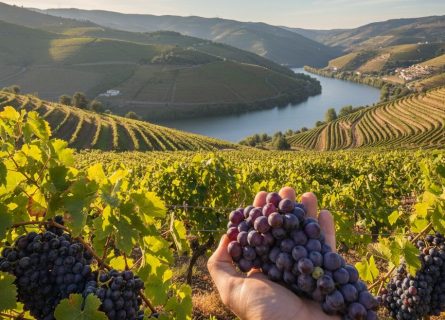
Understanding Portuguese Wine: History, Regions & Traditions
November 20, 2025
Explore the exceptional qualities of Portuguese wine, highlighting unique blends and the elegance of native grape varieties.
By: Barnaby Eales / Last updated: June 9, 2025
Looking at the hilly municipality of Gaia (as Vilanova de Gaia is known) across the river from downtown Porto city, the historic Port house names are illuminated in big letters on boards, breaking through the rolling mist. Port, a fortified wine known for its long aging ability, is by far the best-known cultural asset of Portugal’s second city.
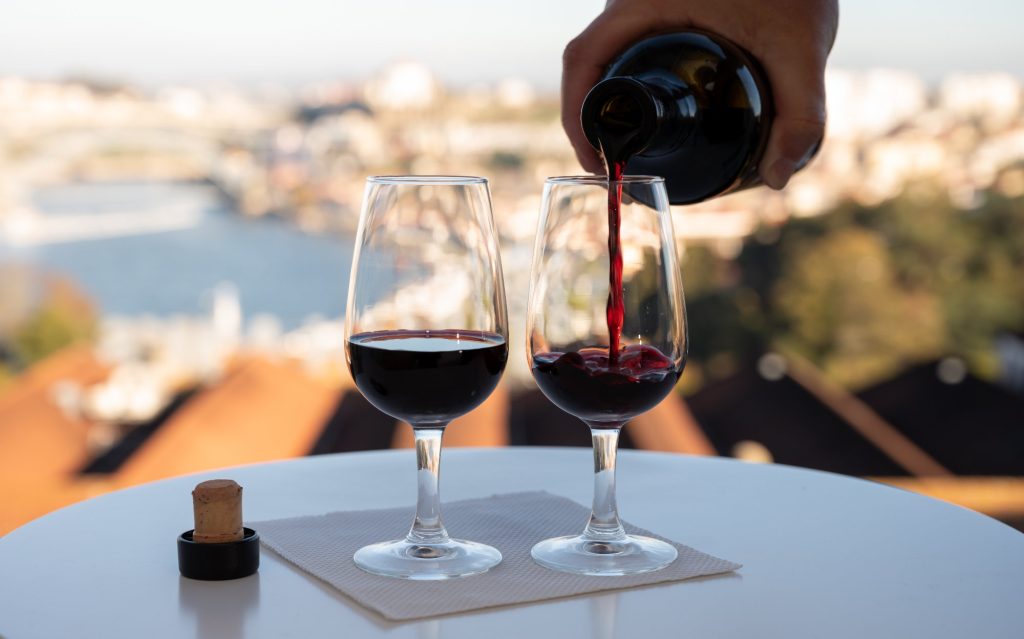
Port wine production began in the 17th century, when British merchants began shipping the fortified wines back to the British Isles—the steep and rocky schist soils of the spectacular Douro Valley, a UNESCO World Heritage site, proved ideal for grape cultivation.
According to legend, two English merchants visiting the Douro municipality of Lamego discovered a local abbot adding aguardiente (grape spirit) to halt the fermentation early. This technique helped preserve sweetness and enabled the wine to withstand long sea voyages to Britain. Thus began the enduring love affair between the British Isles and Port wine.
Over the next century, the trade flourished, supported by Anglo-Portuguese trade accords and increased demand in Britain. However, by the mid-18th century, prices fell due to market forces and growing concerns over adulteration—accusations that producers were adding elderberry to Port and blending Spanish wine to deepen its color. There were even reports of English merchants producing counterfeit Port.
In response, the Port Viticultors created the Companhia Geral dos Vinhos do Alto Douro to protect their interests. This group was established by the Royal Charter in 1756. Its first task was to create the Douro Wine region appellation, ensure quality, balance production, trade, and equalize prices.
During the 19th century, the region became even more popular during the Napoleonic Wars, and a trade embargo on French wines allowed the Portuguese to increase their market share in the important British market.
Ever tried squashing a bunch of grapes with your feet at home? Foot-treading is a festive, celebratory event during which treaders sing the merits of each harvest. Feet are an efficient method for crushing the grapes to extract color and flavor quickly without cracking the pips, avoiding bitter flavors. This old tradition is usually performed in shallow stone fermentation troughs called lagares.
People still foot tread today, although Symington, the biggest vineyard owner in the Douro, has used robotic foot treading over the past 25 years.
After the foot pressing, the grape juice is fermented in large wooden vats or stainless steel tanks for about two days (a short period compared to still wine fermentation). The addition of ‘aguardente vínica‘, a clear grape spirit made from pomace (usually 77% ABV), stops fermentation. The timing of the aguardente addition determines the Port wine’s sweetness level.
Port is said to be fortified once the desired sugar and alcohol levels are reached—typically between 19% and 22% ABV—enabling it to age gracefully for decades.
Until 1987, it was a legal requirement to age Port wine at the port lodges in the cooler maritime climate of Gaia.
However, in 1987, the Instituto dos Vinhos do Douro e do Porto (IVDP) introduced significant regulatory changes affecting Port’s aging, including allowing it to be aged in modern air-conditioned warehouses in the Douro region, closer to the vineyards. That said, some producers still age Port in barrels in Gaia—top producers, like Niepoort, also age Port in glass demijohns for at least seven years. Blending ports of different ages is a key skill in port production.
Other regulatory changes included the “Reserve” category, Age-Designated Tawnies standardization, and clarification of “Colheita” style requirements.
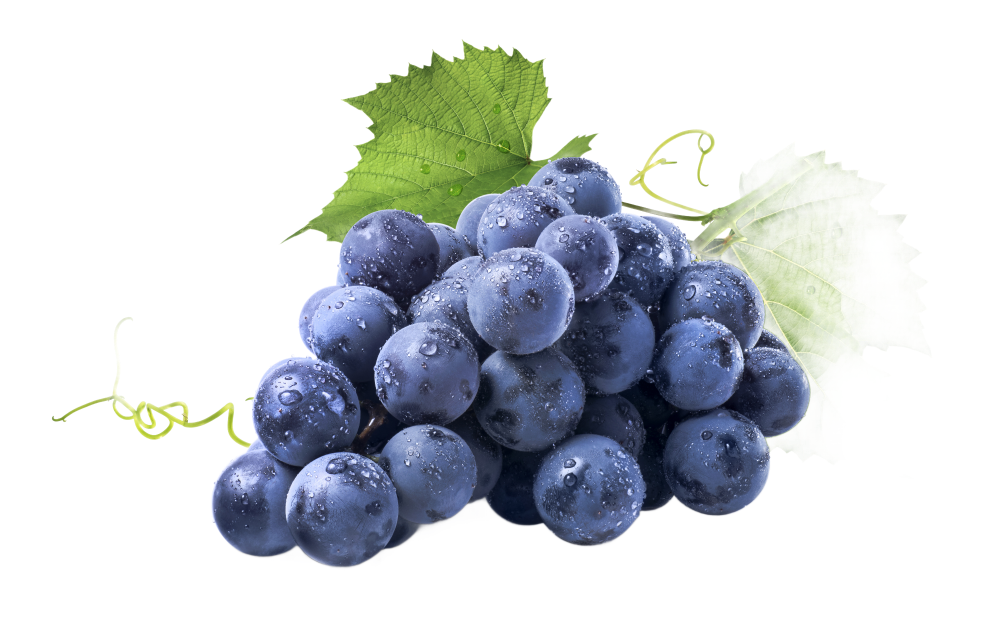
Astonishingly, 116 grape varieties are permitted in the Douro appellation, 30 of which are regularly used. Most grapes are red varieties, including:
Touriga Nacional:
Touriga is known for its notes of black fruits, firm tannins, and natural acidity. It is widely seen in Portugal as the country’s best local red grape.
Learn more about the Touriga Nacional Grape
Touriga Roriz:
It has intense black and red fruit flavors, not only of the Douro but also of the Iberian Peninsula—Touriga Roriz is another name for Tempranillo, the predominant grape used in Rioja, or Aragones as it’s known elsewhere in Portugal.
Learn more about the Touriga Roriz Grape
Other Notable Red Grapes:
Other predominant red grape varieties providing stability to blends include Tinta Amarela, Touriga Franca (previously known as Touriga Francesa), Touriga Cão, Touriga Barroco, Bastardo, Mourisco Tinto, Cornifesto, and Donzelinho.
White Grapes:
While Port has traditionally been about fortifying red wine, in recent years, white Port has come to the fore; the elegance of old white Ports is arguably more acute and fine than the reds. White grape varieties known for their delicate and bright aromatics and acidity are used to make White Port, including Gouveio, Viosinho, Malvasia, Esgana Cão (a Dog strangler due to its high acidity levels), Rabigato (a Cat’s tail), and Folgasão.
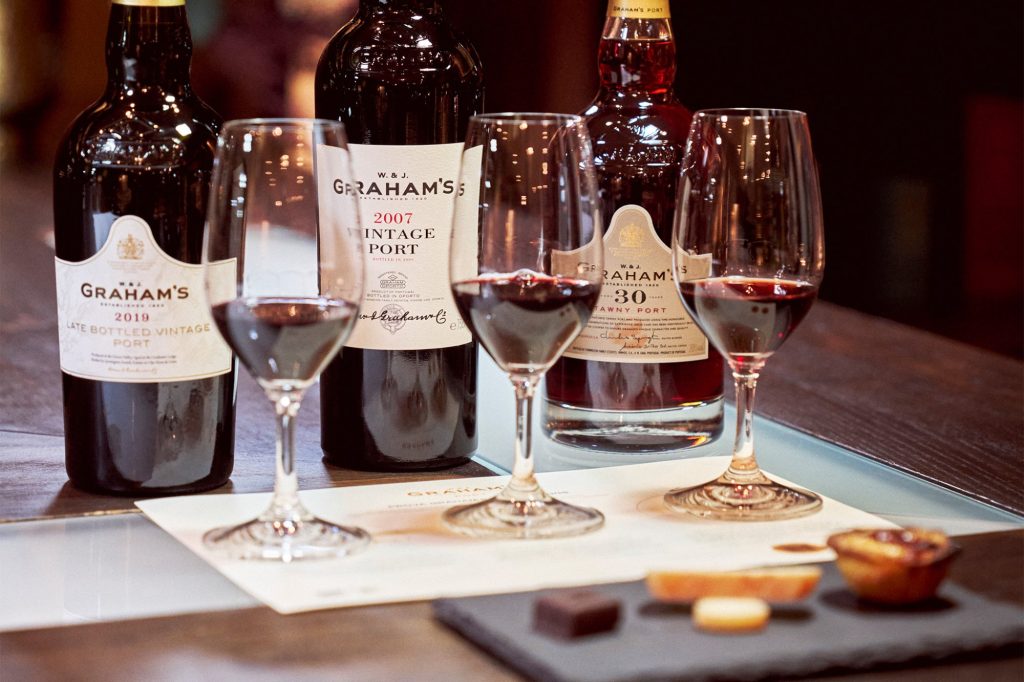
Other than sweetness levels, styles are usually determined by whether the aging is in bottle or oak barrels. The key styles are Ruby, Tawny, and White ports. Style categories are labelled on bottles.
Bright, bold, youthful, fruit-forward Ruby ports – named after their colour – are bottled after up to three years of aging with fruit flavors of plum, jam, blackberry, blackcurrant, cherry, chocolate, and liquorice. Ruby ports are usually made from grapes grown in the lower, western end of the Douro valley.
Aging: 2-3 years in large wooden vats
Ruby Reserve is a higher level of Ruby port. Producers select riper, more concentrated grapes from higher-quality parcels with lower yields. It is a blend of premium Port aged longer than Ruby, and must undergo a blind tasting to receive the “reserve” label.
Aging: 3-5 years in large wooden vats
Tawny Port is made by blending wines of different ages and maturing them for extended periods in oak casks. Through aging and oxidation, Tawny Ports develop a rich amber-brown colour, with notes of fig, orange, nuts, and caramel. Age designations—10, 20, 30, 40 years—reflect the average age of the blend, not a single vintage. Tawny is bottled ready to drink and does not require further aging after release.
It is said in Portugal that Tawny Port is the Queen, and Vintage Port is the King. Dark and rich Vintage Ports, aged in bottle, are declared Vintage Port after harvest, only in the best years when optimal ripeness has been achieved in grapes grown in small plots in the best parcels. Vintage Ports are bottled without fining or filtration, preserving their character. Single Quinta Vintage Ports are made from grapes grown on a single estate.
Vintage Port wines are aged for 2 years in large oak vats. Once bottled, they continue to mature, often for 50 years or more, developing remarkable depth and complexity over time.
LBV Ports are aged in oak barrels for 4 to 6 years after the harvest. Unlike Tawny Ports, which undergo oxidative aging in smaller barrels (leading to nutty, amber characteristics), LBVs maintain fresh red and black fruit notes, typical of the Ruby family..
Crusted Port is aged in large wooden vats for about 4 years and then in bottle for three years before being released for sale. It is bottled without filtration, which results in the formation of a natural deposit, known as the ‘crust.’
Ranging from pale, straw to gold in colour, and flavors from citrus to apricot, almonds, and caramel, depending on aging. Some contemporary White Ports are lower in alcohol at 16.5%. Variations from dry to sweet and the same aging indications as Tawny and Colheita ports are permitted.
Now widely produced, using short cold maceration of red grapes
Port should be stored in a cool, dark, dry, and humid environment. Bottles with a lot of sediment, such as Vintage Ports and those not filtered, should be stood upright for about 30 minutes before serving, allowing the sediment to fall to the bottom of the bottle before decanting.
Port should be served in a broad, wide, deep glass, allowing the aromas to flow.
| Pink Port | 4°C / 39°F |
| White Port | 6°C / 42°F |
| Ruby Style | 6–10°C / 42–50°F |
| Tawny Style | 10–14°C / 50–57°F |
| Tawny Ports (slightly chilled) | 10–14°C / 50–57°F |
In the summer, I enjoy a slightly chilled 10-year-old Tawny or Tawny Reserve, sometimes served with an ice cube. It pairs beautifully with pâté, dried fruits, nuts, and strong cheeses.
White Port: Lighter, younger White Ports pair well with salads, salmon, rich fish, creamy soups, and seafood. Fuller-bodied styles complement grilled fish and chicken.
LBV: Intensely flavored Late Bottled Vintage pairs beautifully with steak or duck, especially when served with rich, savory sauces.
Ruby Port: Young Ruby-style Ports pair well with chocolate-based desserts, cakes, and cheesecake.
Tawny Port: A 10-year-old Tawny pairs wonderfully with ice cream or other creamy desserts. Intense, mature cheeses—especially Stilton—complement older Tawnies aged 20 years or more. In the heat of summer, a slightly chilled Tawny enjoyed after lunch is exceptionally refreshing.
Vintage Port: Best enjoyed as a post-meal digestif, this is the perfect moment to uncork a well-aged bottle—ideally one that has matured for at least 20 years.
Portonic (white Port and tonic) is a refreshing sharpener to start an evening before dinner, especially in the summer. Much lower in alcohol than G&T and other spirits, it has recently become my go-to drink.
Port appears to have shaken off its old image of an ‘old boys’ drink, drunk by men of a certain age. With declining consumption, Port producers have been looking for ways of revitalising the category; artisanal producers are making lighter, drier ports with less intervention.
Modern packaging, like cans, and Port’s sweetness make it an ideal cocktail ingredient. It is much more versatile than you may have thought—who would have known?
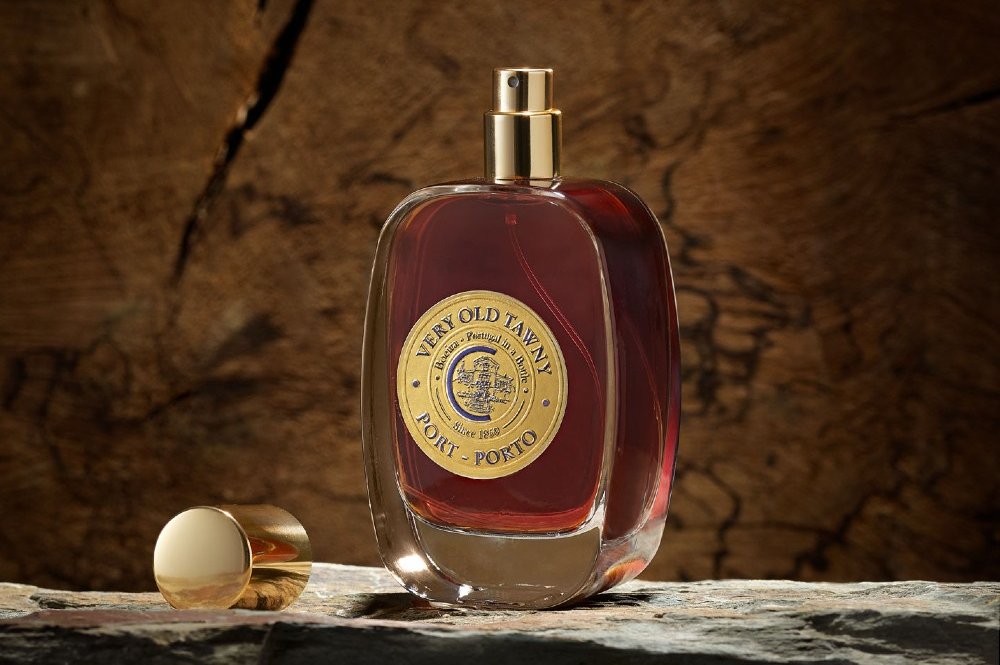
I recommend Quinta de Boeira’s Very Old Tawny Port for a unique and surprisingly affordable taste of old Port. Made over a century ago, in 1917, it’s presented in a striking perfume-style bottle. Enjoy the history of Port by spraying it into your mouth from the bottle—a new and fun way to enjoy Port!
The best way to enjoy and appreciate Port is to try all the different styles, starting with younger, fiery Ruby-style Ports and then moving on to barrel-aged Tawny Ports. Twenty-year-old Tawny Ports have the beauty of developed flavors while retaining freshness. Producer Niepoort is always the first stop when trying Ports. Grahams and Taylor’s are well-established quality brands of the ‘old boy’ companies. However, many lesser-known artisanal port producers make organic and biodynamic ports to discover and unearth.
Producers like Quinta do Infantado and Ameztoy & Almeida, for example, make lighter Ports from wine by using less aguardente in the fortification process; wines are fermented over a longer period, leading to natural alcohol levels. When seeking a high-quality Port without the high price tag of Vintage Port, consider alternatives like Late Bottled Vintage (LBV), Crusted, or Colheita Ports.
Read the blog post on The Best Vintage Ports
Versatility is one word that describes Port and the Douro Valley: not only is the Douro home to dozens of local grape varieties, but it is also reflected in the diversity of its vast vineyard area, which ranges from 150 to around 800 meters above sea level. The wide range of grape varieties is helping producers grapple with the onslaught of climate change in much of the hot and dry Douro.
Meanwhile, lighter, drier styles of Port wine with less intervention are gaining ground, with Port sold in new formats. To learn and enjoy Port wine, there is nothing better than going to Porto and the Douro to witness the staggering transformation of the city and region, since Portugal joined the EU in 1986, regarding infrastructure and services. Despite the challenges of climate, being a popular tourist destination, and the rapid decline in the number of Douro growers, the vinous soul and history of Port, the Douro, and Portugal live on.
Together with the experience of several visits to Porto in recent years, here are my references:
If you would like us to customize an exclusive luxury tour, contact us and let us know your travel plans. We offer luxury food and wine tours for private groups of a minimum two guests. In addition, all of our private, chauffeured tours are available year-round upon request.

